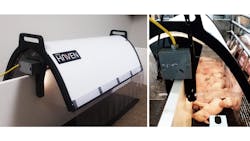Seoul Viosys and SETi say UV-B LEDs will enhance livestock production
Sensor Electronic Technology Inc (SETi) and Seoul Viosys, ultraviolet (UV)-focused business units of Seoul Semiconductor, have announced the results of research from Iowa State University that indicates UV-B-band (280–315-nm) energy might enhance pork production. Many piglet farrowing facilities operate indoors today, and the piglets are not exposed to sunlight, resulting in vitamin D deficiency. Daily UV-B exposure can raise vitamin D levels and specifically prompt natural production of vitamin D3. Seoul and SETi say the results may suggest that other livestock as well as fish, birds, and more might be positively impacted by UV-B exposure.
The Iowa State experiment was titled “Effect of UVB light supplementation on pre-weaning piglet vitamin D3 synthesis and productivity” and was the focus of the doctoral dissertation by Dr. Ben Smith. The UV-B solid-state lighting (SSL) was developed by a company called FarrPro and is expected to be commercially available early next year. The experiment documented the rise in piglet D3 levels with no negative effects such as sunburn. The full results will be published in an upcoming issue of the academic journal Animals.
“Vitamin D is essential to the function of every major system of the body. Unfortunately, animals raised indoors don’t have access to sunlight and supplementation is difficult,” said Amos Petersen, CEO of FarrPro. “VitaLight will change that, passively reducing illness, injury, antibiotic use and stress in livestock, producing animals that are healthier, happier, and more profitable.”
Earlier research in Denmark from the University of Copenhagen and from the Technical University of Denmark also established that UV-B light from legacy tubes could raise vitamin D, and specifically D3, levels in piglets. Now the Iowa State research has shown similar results with LED sources. There is still research needed to document precisely how the D3 synthesis might improve production, but at the very least it should boost immune levels and enhance litter health.
The span of life science applications for LED technology continues to amaze. More than a half decade ago, we published an article about how LED lighting could improve chicken production. That article followed a presentation on the topic at Strategies in Light 2014.
More recently, we wrote about how LED lighting is helping to boost farmed salmon production. The SSL causes the fish to swim deeper and avoid sea lice infestation.
We further wrote a few years back about how LED lighting was being used to boost milk production at northern dairies. Short days, especially in winter, resulted in less milk production. LED lighting can essentially extend the day and in turn the production in an energy-efficient manner.
LEDs Magazine chief editor MAURY WRIGHT is an electronics engineer turned technology journalist, who has focused specifically on the LED & Lighting industry for the past decade.
For up-to-the-minute LED and SSL updates, why not follow us on Twitter? You’ll find curated content and commentary, as well as information on industry events, webcasts, and surveys on our LinkedIn Company Page and our Facebook page.

Maury Wright | Editor in Chief
Maury Wright is an electronics engineer turned technology journalist, who has focused specifically on the LED & Lighting industry for the past decade. Wright first wrote for LEDs Magazine as a contractor in 2010, and took over as Editor-in-Chief in 2012. He has broad experience in technology areas ranging from microprocessors to digital media to wireless networks that he gained over 30 years in the trade press. Wright has experience running global editorial operations, such as during his tenure as worldwide editorial director of EDN Magazine, and has been instrumental in launching publication websites going back to the earliest days of the Internet. Wright has won numerous industry awards, including multiple ASBPE national awards for B2B journalism excellence, and has received finalist recognition for LEDs Magazine in the FOLIO Eddie Awards. He received a BS in electrical engineering from Auburn University.





